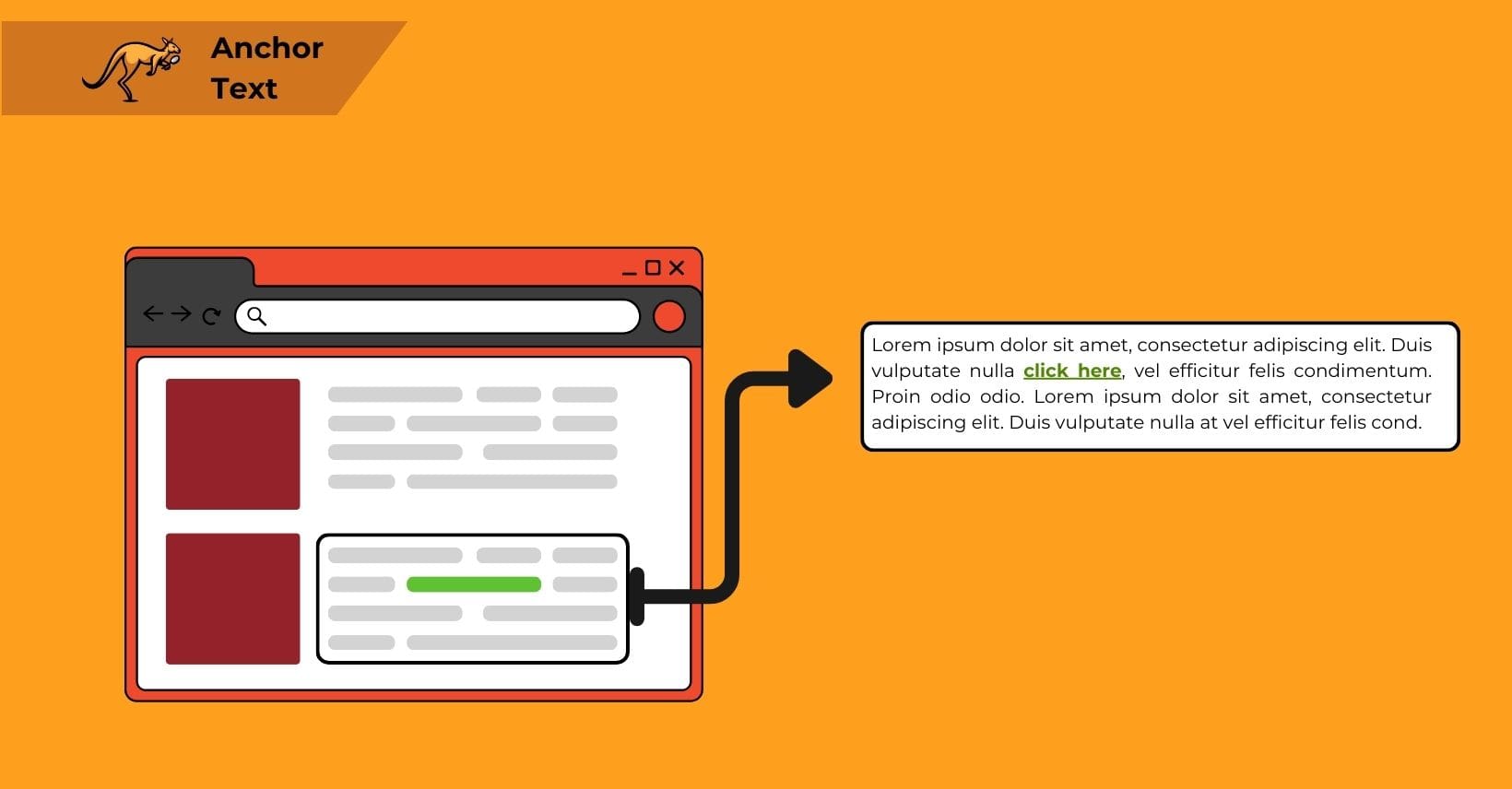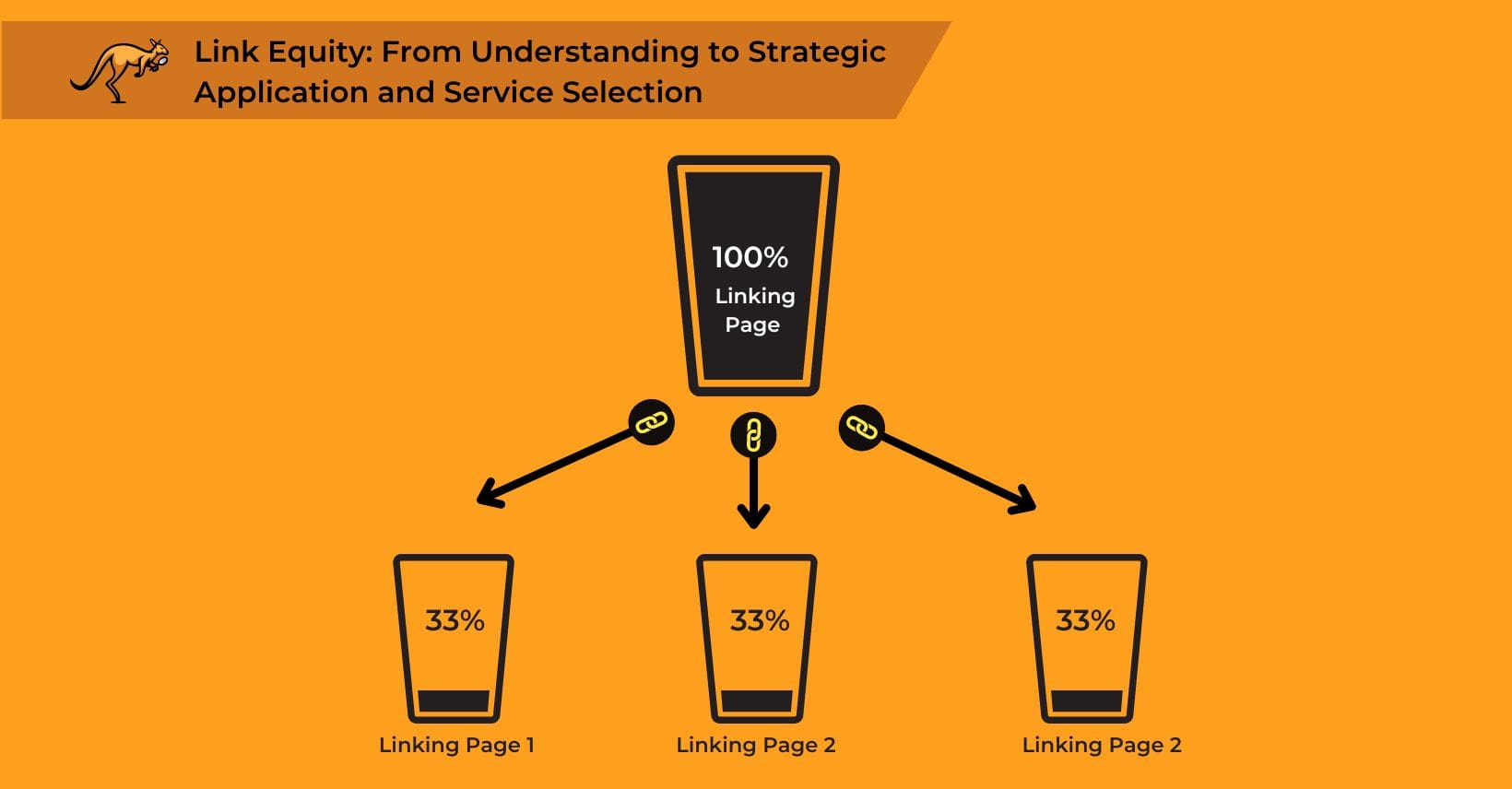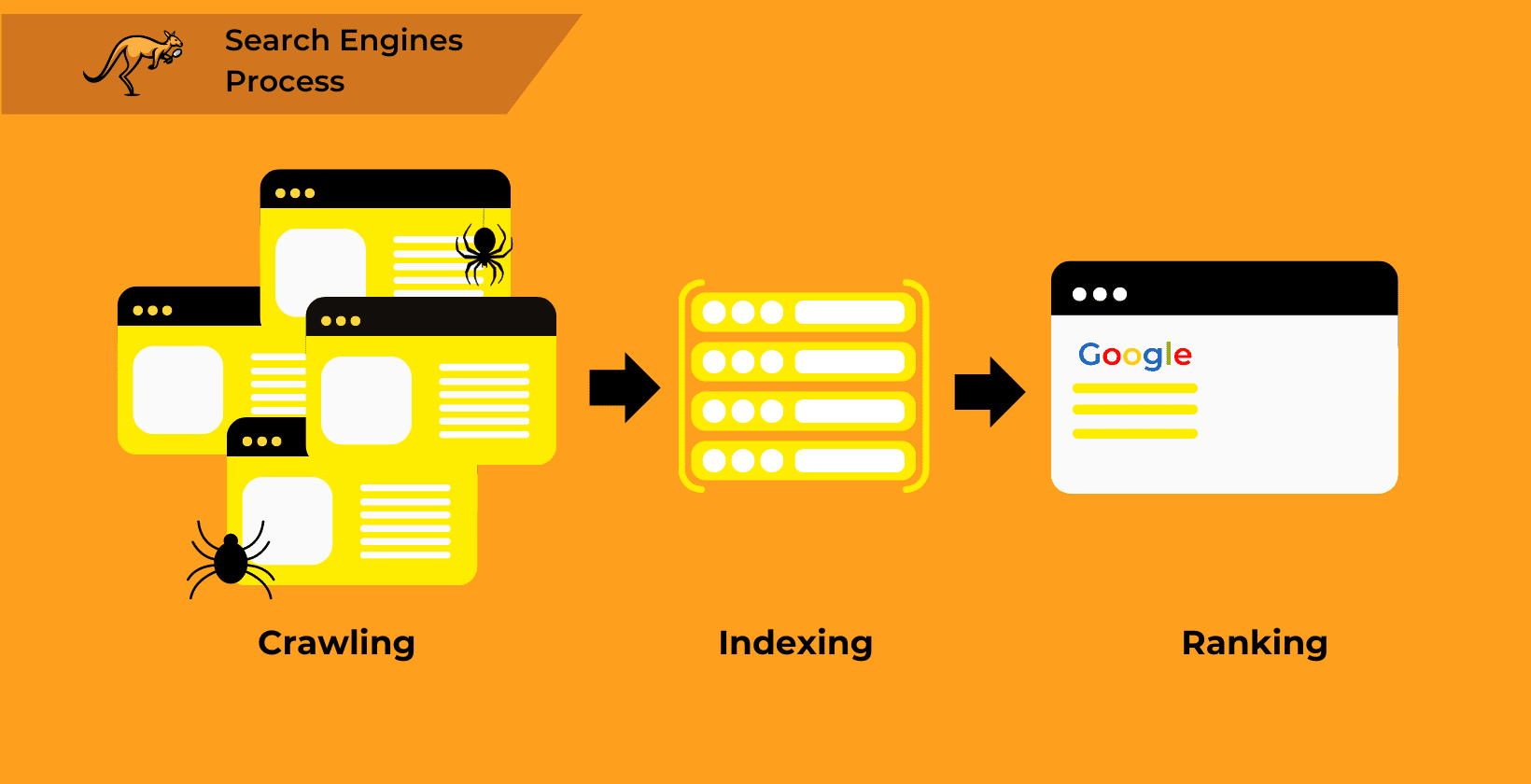Anchor text, a link label, is simply the visible, clickable text in a hyperlink. Its primary function is to be attached to links, but its importance extends beyond mere functionality.
For search engine optimization (SEO), understanding how search engines use anchor text to interpret and connect different web pages is crucial.
This understanding helps in effectively utilizing link building to enhance SEO performance.
It’s helpful to consider how these connections influence the relevance and authority of web pages, leading us to examine the specifics of anchor text on pages.
What is Anchor Text on Pages?
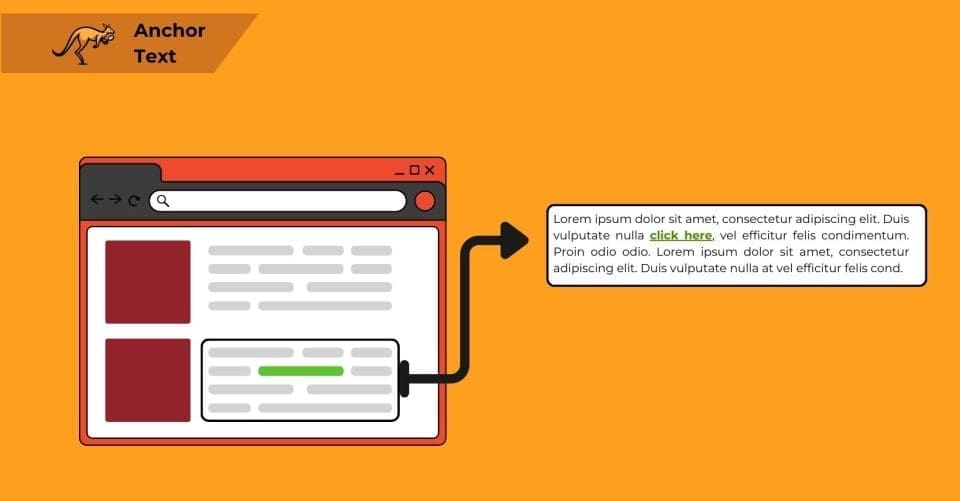
When you encounter a link, it’s typically highlighted in blue and underlined to differentiate it from the surrounding text.
This highlight is the anchor text, providing context and indicating the link’s content and purpose. Anchor text is crucial for both user experience and search engine optimization (SEO), as it informs search engines and website visitors about the link’s content.
Good anchor text can directly influence the effectiveness of a link by improving its visibility and relevance in search results.
As we discuss the elements that contribute to effective web navigation, one might wonder about anchor text’s specific roles and importance in directing digital traffic.
Why Does Anchor Text Matter?
Anchor text plays a critical role in search engine optimization (SEO) by influencing a website’s visibility on search platforms.
When a search engine crawler identifies a hyperlink, it logs the anchor text alongside contextual details and information about both the source page and the destination page.
The effectiveness of anchor text depends on its relevance to the content of the linked page and its surrounding text, which in turn affects the strength of the SEO boost, commonly referred to as “link juice.” The choice of keywords within the anchor text is particularly pivotal in determining the link’s value.
Considering the strategic use of anchor text, it becomes clear that the variety in its formulation can significantly impact SEO outcomes.
Types of Anchor Text
Anchor text comes in eight distinct types, each tailored for specific uses.
Selecting the right type is vital as it determines the clickable text and the link’s context. While crucial for link building, anchor text optimization may be less important in other scenarios.
The choice of anchor text depends on individual circumstances, gaining more value when it aligns well with the linked page and its surrounding content.
This concept encourages us to examine the broader implications for SEO and user interaction on the web.
Generic Anchor Text
Generic anchor text employs non-descriptive phrases such as “click here” or “find out more,” which do not reveal the destination or content of the linked information.
Such anchor texts rely heavily on the surrounding content to provide context, making them less informative.
They are seldom used because they fail to include relevant keywords that could enhance understanding and SEO value.
However, a more strategic approach can be utilized to optimize visibility and user engagement online.
Naked Link Anchor Text
Naked anchor text refers to a hyperlink that uses the URL as its anchor text.
This type of link is commonly found in directories or as references at the end of articles, where simplicity is key.
However, in other settings, a naked URL may disrupt the visual flow of text because it stands out from the surrounding content without blending in.
To maintain a seamless appearance in your content, consider the advantages of branded anchor text, which enhances readability and strengthens brand recognition.
Branded Anchor Text
Branded anchor text explicitly incorporates your brand’s name, which could be your main company name or website.
This type of hyperlink can also refer to any distinct product lines or sub-brands associated with your company, effectively highlighting different facets of your business identity in your digital content.
By using branded anchor text, you identify different sections or offerings of your business, making it a strategic choice for directing traffic precisely where you intend.
Similarly, employing specific keywords in your anchor text plays a crucial role in enhancing visibility and aligning with your audience’s search interests.
Brand and Keyword Anchor Text
Anchor texts frequently include additional keywords to slightly modify the brand reference, enhancing the link’s context.
For instance, using “Jim’s Hot Dogs recipe page” instead of merely “Jim’s Hot Dogs” clarifies the linked page’s content while still featuring the brand name.
These strategic inclusions preserve brand identity and enrich the link, which is pivotal for effective SEO practices.
This method of embedding keywords seamlessly integrates crucial information within anchor texts, setting the stage for exploring the nuances of exact match anchor texts.
Exact Match Anchor Text
Exact match anchor text strictly contains the specific keyword associated with the linked page.
For instance, if a page is titled Hats, the exact match anchor text would simply be “hats.” Such anchor texts incorporate precisely the targeted keyword or phrase, with no deviations or additional content.
Exploring the subtleties of how keywords connect to their respective content enriches our understanding.
It sets the stage for further discussion on leveraging the next type of anchor text, the partial match anchor text, which subtly incorporates related terms alongside the main keyword.
Partial Match Anchor Text
Partial match anchor text, commonly called phrase match, introduces variations of a target keyword within a link’s anchor text.
For instance, while “hats” may serve as an exact match keyword, a phrase match example could be “green waterproof hats.”
This approach retains the original keyword and enriches the link with additional, relevant context. Such anchor texts effectively direct users to web pages that match their search intent more closely.
Considering the effectiveness of different anchor texts, exploring how they impact search engine optimization and user experience is useful. This brings us to the importance of understanding relevant keywords anchor text.
Relevant Keywords Anchor Text
Relevant keywords function similarly to partial matches, though they don’t contain the exact target keyword. Instead, these terms are closely related to the core topic of the original content.
For instance, rather than using “hats,” the text may mention “baseball caps,” maintaining relevance without direct keyword usage.
Following these related topics, the effectiveness of linking strategies can be visualized in various ways, including the upcoming display of image links that illustrate these concepts.
Image Links
When a webpage is linked through an image, traditional anchor text does not apply. Instead, the “alt” attribute of the image serves as the anchor text.
This alt text, invisible unless the image fails to load or is hovered over, is recognized by search engines as the anchor text for the link.
Therefore, the alt attribute effectively becomes the anchor text, seamlessly integrating with search engine algorithms to convey the intended meaning of the hyperlink.
Understanding the dynamics of this conversion from image attributes to link descriptors leads us to consider what elements constitute effective anchor text.
What makes Good Anchor Text?
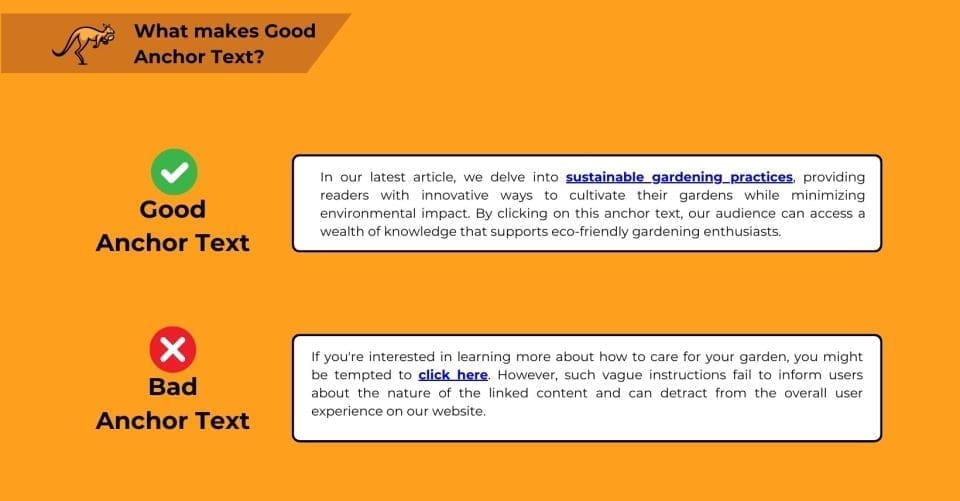
While SEO may not always be the primary concern, it is essential to master creating effective anchor text.
Good anchor text simplifies linking one web page to multiple others, enhancing the user experience.
Understanding how to construct high-quality anchor text involves recognizing the relationships between RDF triples—subject, predicate, and object—that define the web of data.
Considering how these elements contribute to a seamless browsing experience, it’s also crucial to explore factors such as text relevance, contextual information, and even the optimization of image alt text to ensure content remains accessible and relevant.
Text Relevance
You always want to choose anchor text that offers some relevance.
Ideally, the anchor text should relate to whatever the link’s destination is, usually meaning the page titles and content.
A link with “click here” anchor text is much less effective than one with relevant, custom anchor text linked to the same page.
Overall Relevance
External anchor text has the most SEO potential when it is relevant to both the source content and the target content.
This is important because it means that the anchor text has to bridge the gap between two sites.
When link building, more relevancy almost always means greater SEO potential, so choosing something relevant does have an impact.
For example, if web pages from blogs about clothes are pointed at clothing company websites, the anchor text performs better if it relates to the clothing mentioned in the article and on the target page.
Natural Language
You never want anchor text to seem like a jarring switch in tone or grammar if you can help it.
Not only can this harm search engine rankings, but it also makes the link look much more sloppy and obviously placed to readers.
If the text has no flow into the preceding and following sentence structure, it might be much less effective, especially if you have forced the link into a context that does not make sense.
Over-Optimization
The mention of “forcing a link” in the above example also applies here.
While manipulating anchor text is expected, forcing in highly-optimized anchor text can sometimes backfire horribly.
Excessive optimization, such as using the same keyword over and over again, can severely damage the SEO potential of the entire page – or even the entire site.
Mixing up keywords and creating keyword-rich anchors that still flow well with the text is important for getting the best results possible, especially when aiming to attract real estate leads organically.
This is also why descriptive keywords are so useful – they are much more authentic than simply keyword-stuffing each piece of anchor text.
Contextual Information
Whenever a link points to another page, it is not just the anchor text that matters.
The contextual text surrounding anchor text is also important and can completely change a search engine’s understanding of a link.
For example, with the keyword “code tutorials,” a phrase like “check out our HTML code tutorials here” tells you what the target page offers.
However, a phrase like “check out our free HTML code tutorials here, along with video guides” adds more contextual details, even though the link itself is the same two words in both.
This is something that many search platforms take into account, so be sure that you think about more than just the link itself.
Image Alt Text
Alt attributes in images are crucial for effective SEO practices.
Alt attributes serve as the anchor text for images used as links, providing essential context that otherwise would be missing if the alt attribute is absent.
When an image link lacks an alt text, it reduces to a mere naked URL, lacking descriptive text or a link title, which can hinder effective user engagement and, subsequently, the conversion of website traffic into sales.
Conversely, overloading an image’s alt text with excessive keywords can be counterproductive, as images typically benefit from a concise keyword strategy.
Moreover, each image should link to a distinct URL, necessitating multiple images for multiple links, each properly equipped with its anchor text.
Learning will enhance our grasp of how search engines interpret and utilize anchor text, a critical component in optimizing digital content.
How Search Engines See Anchor Text
Search engines interpret anchor text by assessing the hyperlink and its contextual environment, including its destination.
By examining their format and presence on web pages, they can recognize whether links are for external or internal purposes.
This advanced view allows search engines to understand the link’s context far more effectively than typical users, given their capacity to simultaneously process a broad array of data.
While users may overlook the repeated use of the same anchor text in an article, such repetition can prompt Google’s scrutiny, potentially activating spam filters due to the redundant use of text.
This precise monitoring of link usage and context leads naturally to further considerations of how these factors influence the evaluation of a page’s relevance.
Relevancy Checks
Search engines evaluate the correlation between the anchor text and the content on the destination page to ensure alignment. Suppose the anchor text lacks a connection with the destination content.
In that case, search engines will likely deem it less valuable than more relevant alternatives. This principle holds for both external and internal linking strategies, prompting webmasters to favor descriptive links over bare URLs on their websites.
Relevance encompasses various elements, including page titles, content, metadata, and even the associated brand.
Such precision in linking ensures the web remains an informative and interconnected space, paving the way for discussions on topics like spam anchor text, which may also impact a link’s value.
Spam Anchor Text
Anchor text relevance plays a pivotal role in the effectiveness of hyperlinks, yet choosing irrelevant or inappropriate anchor text always detracts from this goal.
“Spam” in this context refers to anchor text mismatched with the linked or surrounding content, often including excessive keywords or an overload of links on a single page.
Such practices have severe repercussions on search engine rankings, as search engines like Google typically flagged and devalued them, which has introduced updates to penalize these spam links.
Consequently, these links fail to enhance SEO performance and may actively harm it by resulting in penalties.
Considering the flow of content and its authenticity, let’s see how natural language processing aids in optimizing content strategies.
Natural Flow and Language
When constructing anchor text, it’s essential to integrate the links seamlessly within the text, enhancing the natural rhythm and readability of the article.
This approach involves forming connections that are genuine components of the narrative, rather than awkwardly inserting them in a way that disrupts the textual flow.
Overly conspicuous links, especially those resulting from forced keyword inclusion or grammatical incongruities, will likely incur penalties from search engines.
Such practices attract negative algorithms and degrade the reader’s experience. A subtle yet effective integration of anchor texts maintains SEO integrity.
It preserves the content’s enjoyment, moving us to an exploration of effective linking strategies and their destinations in digital content.
Link Destinations
Anchor texts should ideally point to relevant pages, enhancing your website’s usability and SEO performance.
When anchor texts link internally or to an external site, selecting destinations that align closely with the page title and content proves crucial for search engine optimization.
Diverging too far from these elements can obscure your site’s visibility and ranking.
In some instances, modifying the destination to align better with the anchor text might boost your SEO efforts more effectively than changing the text itself. Using anchor texts to link to unrelated pages squanders a potential advantage.
Summing Up: The Essential Guide to Understanding Anchor Text
At the end of the day, anchor text is an extremely versatile part of the SEO world that can be used for a variety of different purposes, from increasing user engagement to boosting page rankings.
That said, over-optimization and spammy techniques can backfire horribly, and it is always important to remember that user experience and content quality matter as well.
Whether you are tweaking every href attribute individually or just trying to optimize the links at a surface level, it is important to be careful.
Like any SEO technique, one wrong change is all it takes to make a link worthless or at least devalue it severely.
While anchor text is not the only tool in the SEO toolbox, it can have a serious impact on search engine results.
Using it wisely is always the first step to making your site’s links more optimized.
